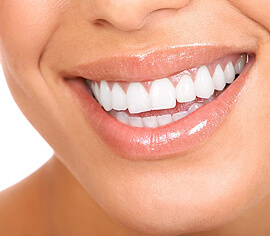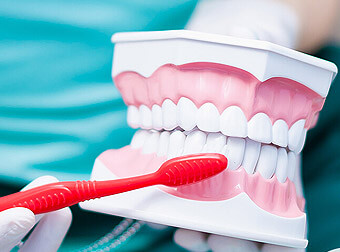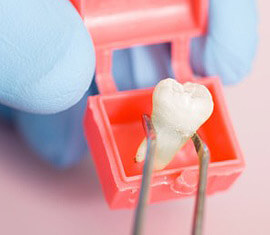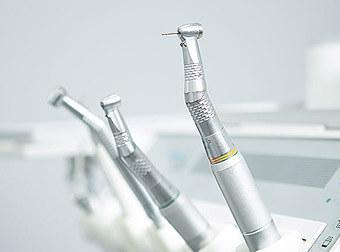
Teeth whitening involves bleaching your teeth to make them lighter. Teeth whitening can't make your teeth brilliant white, but it can lighten the existing colour by several shades. Teeth whitening is a form of dentistry and should only be performed by a dentist or another regulated dental professional, such as a dental hygienist or dental therapist, on the prescription of a dentist.
Teeth whitening is a form of dentistry and should only be performed by a dentist or another regulated dental professional, such as a dental hygienist or dental therapist, on the prescription of a dentist. If you have teeth whitening you will need to make several visits to the dental surgery over a couple of months.

Then, using your mouthguard at home, you regularly apply the gel for a specified period of time over 2 to 4 weeks. Some whitening gels can be left on for up to 8 hours at a time, which shortens the treatment period to 1 week. Another type of teeth whitening system that a dentist can provide is called laser whitening, which is also known as power whitening. This is where a bleaching product is painted onto your teeth and then a light or laser is shone on them to activate the whitening. Laser whitening takes about an hour.


Lasers, have now brought about a big revolution in the field of surgical dentistry. Imagine a visit to a dentist for a surgical procedure, but going through it without any scalpels, needles and stitches!! @ Medox Dental, you can have just that !
The laser treatment is a much more comfortable alternative to the traditional procedures as it requires less anaesthesia. Also, the aftermath can be much more pleasant. Following a laser soft tissue treatment, the patient exhibits no discomfort.
Less bleeding, no stitches, less swelling, virtually no pain and faster healing, makes this an excellent alternative for all those who shiver under the scalpel!!! So now you can have treatments done for periodontal (gum) disease, gum lifts, gum reconstruction and various minor surgeries without fear.
A dental implant is a titanium post (like a tooth root) that is surgically positioned into the jawbone beneath the gum line that allows your dentist to mount replacement teeth or a bridge into that area. An implant doesn't come loose like a denture can. Dental implants also benefit general oral health because they do not have to be anchored to other teeth, like bridges. Dental implants have revolutionized the replacement of teeth. Before the development of dental implants, people with dentures were unable to chew many kinds of food; this has all changed with the widespread use of dental implants.
A dental implant is a titanium screw that fuses with the jawbone. The process of fusing an implant with bone, called osseointegration, involves connecting the implant with a component called an abutment that supports the crown. When an implant replaces a tooth, however, the implant provides stability to the jawbone without damaging teeth. According to the AAID, the long-term success rate for dental implants is 97 percent. Dental implants eliminate the problems associated with other replacement methods, and they allow people to eat anything with confidence.

The longer the implant, the fewer implants needed to support the replacement of many teeth. An implant is placed by first making a slit in the gum tissue over the site of the missing tooth. A preparation is then made in the bone using various sized drills, after which the implant is screwed into the bone before the gum tissue is stitched closed.
This procedure can be performed under local anesthesia or sedation, and it should be a painless operation. The implant must sit for four months before teeth can be placed, but there are some situations in which the implant can be used like a tooth.

Dentistry is defined as the evaluation, diagnosis, prevention and/or treatment (nonsurgical, surgical or related procedures) of diseases, disorders and/or conditions of the oral cavity, maxillofacial area and/or the adjacent and associated structures and their impact on the human body; provided by a dentist, within the scope of his/her education, training and experience, in accordance with the ethics of the profession and applicable law..
Dentistry involves the prevention, diagnosis and treatment of a wide variety of conditions, disorders and diseases affecting the teeth, gums and maxillofacial (associated with the jaw and face) region of the body.General dentists provide services related to the general maintenance of oral hygiene and tooth health.

General dentists are the main providers of dental care to people of all ages. At a routine visit to your family dentist, you will probably have a thorough examination of your mouth (including teeth, gums, and other structures), a professional cleaning, and a discussion about your dental (and overall) health. If your exam reveals the presence of tooth decay, you will probably also have a filling in the affected tooth. Yet these procedures, while common, are hardly the only services your general dentist provides.

Cosmetic dentistry is dentistry aimed at creating a positive change to your teeth and to your smile. Most think of tooth whitening or porcelain veneers, but a cosmetic dentist can provide much more. A skilled, experienced cosmetic dentist can help to improve your appearance, your smile, even your self-esteem, and confidence. Today, cosmetic dentistry has continued to evolve to where cosmetic dentists can address functional and esthetic patient concerns.
Inlays and Onlays-These are also known as indirect fillings, which are made by a dental laboratory, and they are used when a tooth has mild to moderate decay or there is not enough tooth structure to support a filling. Provided there is no damage to the tooth cusps, according to Choice One Dental Care, the inlay is placed directly onto the tooth surface. When the cusp or a greater portion of the tooth is damaged, however, an onlay is used instead to cover the tooth's entire surface.

Composite Bonding-Composite bonding refers to the repair of decayed, damaged or discolored teeth using material that resembles the color of tooth enamel. Your dentist drills out the tooth decay and applies the composite onto the tooth's surface, then "sculpts" it into the right shape before curing it with a high-intensity light. Also referred to as simply "bonding," per the Consumer Guide to Dentistry, this effectively covers the damage to the tooth and gives the appearance of a healthy tooth in its place. Bonding is one of the least expensive cosmetic dentistry procedures available to patients with tooth decay, chipped or cracked teeth and worn-down edges.

Dental Veneers-Typically manufactured from medical-grade ceramic, dental veneers are made individually for each patient to resemble one's natural teeth, according to Bruce Wilderman, DDS. They look exceptionally realistic and can resolve numerous cosmetic problems, ranging from crooked teeth, to cracked or damaged enamel to noticeable gaps between two teeth. The dentist applies the veneer to the front of each tooth using a dental adhesive.

Teeth whitening involves bleaching your teeth to make them lighter. Teeth whitening can't make your teeth brilliant white, but it can lighten the existing colour by several shades. Teeth whitening is a form of dentistry and should only be performed by a dentist or another regulated dental professional, such as a dental hygienist or dental therapist, on the prescription of a dentist.
Teeth whitening is a form of dentistry and should only be performed by a dentist or another regulated dental professional, such as a dental hygienist or dental therapist, on the prescription of a dentist. If you have teeth whitening you will need to make several visits to the dental surgery over a couple of months.

Then, using your mouthguard at home, you regularly apply the gel for a specified period of time over 2 to 4 weeks. Some whitening gels can be left on for up to 8 hours at a time, which shortens the treatment period to 1 week. Another type of teeth whitening system that a dentist can provide is called laser whitening, which is also known as power whitening. This is where a bleaching product is painted onto your teeth and then a light or laser is shone on them to activate the whitening. Laser whitening takes about an hour.
Root canal is a treatment to repair and save a badly damaged or infected tooth instead of removing it. The procedure involves removing the damaged area of the tooth (the pulp) and cleaning and disinfecting it, then filling and sealing it. The common causes affecting the pulp are a cracked tooth, a deep cavity, repeated dental treatment to the tooth or trauma to it. The term "root canal" comes from cleaning of the canals inside the tooth's root.
Many people worry that a root canal will be painful, something that was true in the past. Today, with advanced anesthesia options and surgical techniques - a root canal is as comfortable as getting a filling. An infected tooth (pre-root canal), is usually what causes tooth pain, and a root canal is the solution to this problem. In fact, infected tooth pulp can cause a tooth abscess and can destroy the bone surrounding the tooth.

A treated and restored tooth can last a lifetime with proper care. Root canals have a high success rate and are significantly less expensive than the alternative, tooth extraction and replacement with a bridge or implant. But tooth decay can still occur in treated teeth, so good oral hygiene and regular dental exams are necessary to prevent further problems. To determine the success or failure of root canal treatment, dentists typically compare new X-rays with those taken prior to treatment. This comparison will show whether bone continues to be lost or is being regenerated..
Wisdom teeth are the third and final set of molars that most people get in their late teens or early twenties. Sometimes these teeth can be a valuable asset to the mouth when healthy and properly aligned, but more often, they are misaligned and require removal. When wisdom teeth are misaligned, they may position themselves horizontally, be angled toward or away from the second molars, or be angled inward or outward. Poor alignment of wisdom teeth can crowd or damage adjacent teeth, the jawbone, or nerves.
Wisdom teeth also can be impacted -- they are enclosed within the soft tissue and/or the jawbone or only partially break through or erupt through the gum. Partial eruption of the wisdom teeth allows an opening for bacteria to enter around the tooth and cause an infection, which results in pain, swelling, jaw stiffness, and general illness. Partially erupted teeth are also more prone to tooth decay and gum diseas,e because their hard-to-reach location and awkward positioning makes brushing and flossing difficult.

A wisdom tooth that is fully erupted through the gum can be extracted as easily as any other tooth. However, a wisdom tooth that is underneath the gums and embedded in the jawbone will require an incision into the gums and then removal of the portion of bone that lies over the tooth. Often, for a tooth in this situation, the tooth will be extracted in small sections rather than removed in one piece to minimize the amount of bone that needs to be removed to get the tooth out.

Still, just because your wisdom teeth aren’t a source of pain doesn’t mean there’s nothing wrong. The teeth could be stuck, or impacted. That means they can’t break through your jaw and into your mouth. Maybe your mouth is too small to make room for them, or the teeth could be growing at an angle to other teeth. They can damage the tooth next door if they push up against it.

A dental bridge will hold your other teeth in place and make everyday activities such as eating and talking easier. It can also help preserve your teeth as a lost tooth can cause the remaining teeth to loosen, which may lead to additional tooth loss. Your Aspen Dental practice offers a range of handcrafted dental bridges, from budget-friendly options to state-of-the-art zirconium bridges created with 3D technology. Your dentist will recommend the best bridge options for you and the team at your Aspen Dental practice will partner with you every step of the way..
A bridge is a replacement tooth or teeth that fill the space where one or more teeth are missing. The bridge restores your bite and helps keep the natural shape of your face. Before you get a bridge, your dentist wants you to know more about the steps involved. He or she can advise which type of bridge is best for you.

A missing tooth is a serious matter. Teeth are made to work together. When you lose a tooth, the nearby teeth may tilt or drift into the empty space. The teeth in the opposite jaw may also shift up or down toward the space. This can affect your bite and place more stress on your teeth and jaw joints, possibly causing pain. Teeth that have tipped or drifted are also harder to clean. This puts them at a higher risk for tooth decay and gum disease.When a tooth is missing, the bone may shrink. If that happens, it may change the way the jawbone supports the lips and cheeks. Over time, this can make your face look older.

ut aliquid ex ea commodi consequatur? Quis autem vel eum iure reprehenderit qui in ea voluptate velit esse quam nihil molestiae consequatur. Dvel illum qui dolorem eum fugiat quo voluptas nulla pariatur iste natus error sit voluptatem accusantium doloremque laudantium, totam rem aperiam, eaque ipsa quae. corporis suscipit laboriosam, nisi ut aliquid ex ea commodi consequatur? Quis autem vel eum iure.